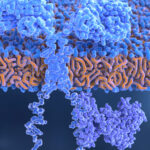Associate Professor Alberta Hoi discusses abstracts on intensified B-cell depletion protocol for lupus nephritis, the promise of a TYK2 inhibitor and CATCR-T cell therapy.
We asked four leading Australian rheumatologists to talk us through research presented at ACR 2022 that excites them and promises interesting changes for the future.
In this article, Associate Professor Alberta Hoi discusses her top lupus research picks.
After somehow managing to shorten her shortlist of 60 (!) down to three, Professor Hoi selected poster 2082 as her first abstract: A prospective study on long-term clinical outcomes of patients with lupus nephritis treated with an intensified B-cell depletion protocol without maintenance therapy.
“I chose this abstract because it has all the elements that enable me to put it in practice right now. And in fact, I had a couple of sick lupus patients that got me thinking about this particular strategy,” said Professor Hoi.
Researchers compared the efficacy of an intensified B-cell depletion therapy (IBCDT) protocol without maintenance to a conventional treatment (either cyclophosphamide or mycophenolate mofetil) and maintenance therapy.
The IBCDT consisted of four weekly doses of rituximab 375mg/m2 and two more doses after one and two months; two infusions of 10mg/kg cyclophosphamide; and three methylprednisolone pulses. This was followed by oral prednisone (tapered to 5mg/d by the third month) and no immunosuppressive maintenance therapy was given.
IBCDT was found to be just as effective as the other treatments, while also reducing the glucocorticoid cumulative dose.
“It really got me thinking about the best way of using combination therapy with rituximab, and also this concept of rapid tapering of a steroid, which is also quite topical and already on a fairly standard protocol – for example in ANCA vasculitis,” said Professor Hoi.
“Obviously, there are some limitations – it’s not a true randomised control study, it’s single centre and quite small numbers, and it’s definitely not advocated for all lupus nephritis patients.”
The next abstract was a phase II study of TYK2 inhibitor deucravacitinib, 1117 Efficacy and safety of deucravacitinib, an oral, selective, allosteric TYK2 inhibitor, in patients with active systemic lupus erythematosus.
This abstract featured in plenary II, and was also a late-breaking abstract at EULAR 2022.
A total of 363 SLE patients with active skin and joint involvement who were on stable background therapy were randomised to receive 3mg or 6mg of DEUC twice daily, 12mg once daily or placebo. Steroids were tapered from week eight to 20 down to 7.5mg per day or less, with further optional tapering from week 32-40.
The primary endpoint was proportion of patients achieving SRI(4) at week 32, achieved by more than half of the 3mg DEUC group versus around one in three in the placebo group. Higher doses of DEUC tended to be associated with more adverse events.
“I think we should definitely watch this space with deucravacitinib in lupus,” said Professor Hoi, adding there is a phase three study underway as well as a cutaneous lupus study.
“There are a number of other indications that they are hoping to look at, for example, in Crohn’s disease. The ulcerative colitis study last year was unfortunately negative, but it is an area where the small molecule TYK2 inhibitor may become useful.
“Some of the [audience] questions were quite interesting: asking what they think is happening mechanistically and how the drug results in the changes in the immunological profile. So there’s still quite a bit that we don’t understand but hopefully more will come with time.”
CAR-T cell therapy in lupus gained a lot of attention at the 2022 ARA ASM, where researchers presented a study of five patients who were in complete remission 300 days after treatment with B-cell-depleting CAR T-cell therapy.
The CATCR-T cell therapy study, 1677 Chimeric autoantigen-T cell receptor (CATCR)-T cell therapies to selectively target autoreactive B cells, presented in plenary III at ACR22, is a variation of that.
Unlike CAR-T cells that indiscriminately destroy all B cells, this therapy selectively eliminates autoreactive B cells while preserving the normal B cell pool.
“This is an in vitro study to look at antiphospholipid syndrome where the anti-beta-2-glycoprotein one domain one antibody is known to be pathogenic,” said Professor Hoi.
“The researcher was able to engineer the T cell receptor to selectively deplete the specific B cells. It works in the same sort of way that the CAR-T cell therapy works in killing the target cells, but in this case it’s very specific to only those B cells that express these autoreactive antibodies.
“There is a dose dependent effect, it’s very selective and it abolishes autoantibody production. So, it’s really a proof of concept of ways that we can devise precision medicines in the future for certain autoimmune diseases where the pathogenic autoantibodies are known.”
Associate Professor Alberta Hoi is a translational researcher at Monash University. Research interests include disease predictors and outcomes in lupus, registry design and implementation, quality of care and patient-centred interactions. She is the chair of the Australian Lupus Registry and Biobank and an executive member of the Asia Pacific Lupus Collaboration.
Rheumatology Republic invited Professor Ranjeny Thomas, Associate Professor Alberta Hoi, Associate Professor Peter Wong and Professor Peter Nash to present three of their favourite ACR 2022 abstracts in a webinar held at the conclusion of the conference.
Read Professor Thomas’s take on RA research here. Professor Wong’s pick of the covid and infection sessions and Professor Nash’s psoriatic arthritis and spondyloarthritis highlights will feature in the coming weeks.
In the meantime, you can see a recording of the full webinar here.




